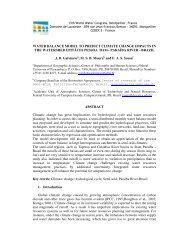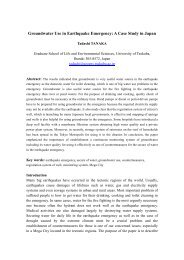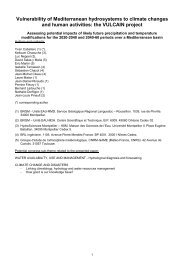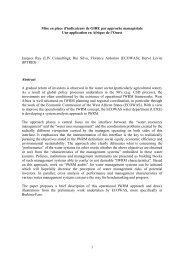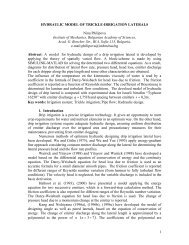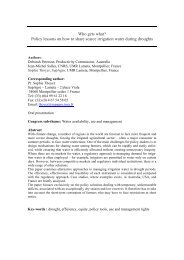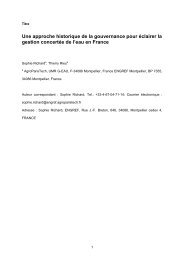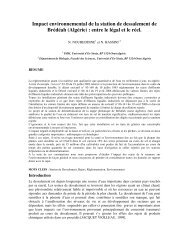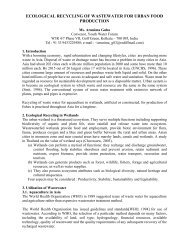Application of Magnetic Resonance Soundings and Other ... - IWRA
Application of Magnetic Resonance Soundings and Other ... - IWRA
Application of Magnetic Resonance Soundings and Other ... - IWRA
You also want an ePaper? Increase the reach of your titles
YUMPU automatically turns print PDFs into web optimized ePapers that Google loves.
APPLICATION OF MAGNETIC RESONANCE SOUNDINGS FORHYDROSTRATIGRAPHIC CHARACTERIZATION OF AN ALLUVIALAQUIFER FOR GROUND-WATER MODEL INPUTSachin D. Shah <strong>and</strong> Wade H. KressU.S. Geological SurveyTexas Water Science Center8027 Exchange DriveAustin, Texas, USA 78754email: sdshah@usgs.gov <strong>and</strong> wkress@usgs.govAnatoly LegchenkoInstitut de Recherche pour le Développement (IRD-LTHE)LTHE, BP53, 38041Grenoble Cedex 9, Franceemail: anatoli.legtchenko@hmg.inpg.frABSTRACTAn integrated surface geophysical pilot study at the Texas A&M University Brazos River HydrologicField Research Site (BRHFRS), College Station, Texas, was done to determine the effectiveness <strong>of</strong> methods fordefining the hydrostratigraphic framework <strong>and</strong> hydrogeologic properties for a ground-water availability model.Time-domain electromagnetic (TDEM) soundings <strong>and</strong> direct-current (2D–DC) resistivity imaging were used todefine the lateral <strong>and</strong> vertical extent <strong>of</strong> the Brazos River alluvium aquifer, the Ships clay within the aquifer, <strong>and</strong>the Yegua Formation underlying the aquifer at the BRHFRS. <strong>Magnetic</strong> resonance soundings (MRS) were used toderive estimates <strong>of</strong> hydrogeologic properties including percentage water content, transmissivity, <strong>and</strong> hydraulicconductivity. Stratigraphically, the principal finding <strong>of</strong> this study was the relation between electrical resistivity<strong>and</strong> the depth <strong>and</strong> thickness <strong>of</strong> the subsurface geologic units at the site. Not only could thicknesses <strong>and</strong> extents <strong>of</strong>these units be defined to a greater level than previously interpreted, but lateral variations in resistivity within thealluvium aquifer also could be detected. MRS data have added supporting data to the 2D–DC resistivity <strong>and</strong>TDEM data allowing for improved underst<strong>and</strong>ing <strong>of</strong> the hydrostratigraphic framework. Hydrostratigraphically,individual hydraulic conductivity values derived from MRS were in close agreement with previously conductedaquifer tests. Average hydraulic conductivity values from the aquifer test are about 61 to 80 m/d, whereas, theMRS-derived hydraulic conductivity values are about 27 to 97 m/d. Results from the geophysics studydemonstrated the usefulness <strong>of</strong> combined TDEM, 2D–DC resistivity, <strong>and</strong> MRS methods to reduce the need foradditional boreholes <strong>and</strong> to create more accurate ground-water availability models using the acquired data.INTRODUCTIONThe Brazos River alluvium aquifer is used primarily as a source <strong>of</strong> supply for drinking water <strong>and</strong>agriculture in Texas <strong>and</strong> is defined by the Texas Water Development Board (TWDB) as a minor aquifer(Ashworth <strong>and</strong> Hopkins, 1995). A projected doubling <strong>of</strong> the Texas population by 2050, as well as the constantthreat <strong>of</strong> drought, necessitates the development <strong>of</strong> effective water-management plans <strong>and</strong> requires accuratecharacterization <strong>of</strong> both the geology <strong>and</strong> hydrostratigraphy <strong>of</strong> the aquifer. A ground-water availability model(GAM) for the Brazos River alluvium aquifer needs valid hydraulic conductivity, transmissivity, storagecoefficients, <strong>and</strong> other properties to simulate changes in water levels in the aquifer due to pumping <strong>and</strong> droughtconditions. The GAM includes information on hydrostratigraphic characteristics such as hydraulic conductivity,specific capacity, <strong>and</strong> transmissivity (Shah <strong>and</strong> Houston, 2007); however, numerous data gaps exist throughoutthe extent <strong>of</strong> the aquifer <strong>and</strong> require collection <strong>of</strong> additional information on the aquifer.In July 2006, the U.S. Geological Survey (USGS), in cooperation with the TWDB, did an integratedgeophysical pilot study at the Texas A&M University Brazos River Hydrologic Field Research Site (BRHFRS)
near College Station, Tex. (fig. 1), using two surface geophysical methods—time-domain electromagnetic(TDEM) soundings <strong>and</strong> two-dimensional direct-current (2D–DC) resistivity imaging to estimate the thickness,extent, <strong>and</strong> lateral variation in the resistivity <strong>of</strong> the hydrostratigraphic units—the alluvium <strong>of</strong> the Brazos Riveralluvium aquifer, the Ships clay within the aquifer, <strong>and</strong> the Yegua Formation underlying the aquifer at theBRHFRS. A third method, magnetic resonance sounding (MRS), was used to estimate the hydraulic properties,specifically percentage water content, transmissivity, <strong>and</strong> hydraulic conductivity at the BRHFRS. These datawere integrated to identify the relations between the distribution <strong>of</strong> resistivity <strong>and</strong> hydraulic properties in theBrazos River alluvium aquifer <strong>and</strong> to identify hydrostratigraphic boundaries <strong>of</strong> the Ships clay, the alluvium <strong>of</strong> theBrazos River alluvium aquifer, <strong>and</strong> Yegua Formation.This paper describes the results from the MRS <strong>and</strong> other surface geophysical methods <strong>and</strong> characterizesthe hydrostratigraphy <strong>of</strong> the Brazos River alluvium aquifer. The MRS part <strong>of</strong> the pilot study was done to comparepreviously collected hydraulic conductivity data from aquifer tests in the study area with MRS-derived hydraulicconductivity data. The paper also documents an integrated surface geophysical approach in which thehydrostratigraphy <strong>of</strong> the Brazos River alluvium aquifer at the BRHFRS was interpreted from surface geophysicalmethods.HYDROGEOLOGIC SETTINGThe BRHFRS encompasses 8.5 square hectometers <strong>of</strong> the Brazos River floodplain about 15 kilometers(km) southwest <strong>of</strong> College Station <strong>and</strong> 200 meters (m) west <strong>of</strong> the Brazos River (fig. 1). The BRHFRS wasinitially established in 1993 at the Texas A&M University Research Farm to study ground-water flow <strong>and</strong>agricultural chemical transport in the Brazos River alluvium aquifer (Munster <strong>and</strong> others, 1996). Nests <strong>of</strong> wells atthe BRHFRS were installed to monitor water quality <strong>and</strong> to assess horizontal <strong>and</strong> vertical ground-water gradientsin the Brazos River alluvium aquifer.From oldest to youngest, the geologic units at the BRHFRS are the Tertiary-age Yegua Formation (fig. 2),a shale that functions as the basal confining unit <strong>of</strong> the alluvium aquifer at an average depth <strong>of</strong> about 21 m belowl<strong>and</strong> surface. The Yegua Formation is overlain by the Quaternary-age Brazos River alluvium, which is dividedinto two hydrostratigraphic units—an alluvium aquifer <strong>and</strong> an upper leaky confining unit (fig. 2). The BrazosRiver alluvium aquifer is characterized by a fining-upward sequence <strong>of</strong> coarse s<strong>and</strong> <strong>and</strong> gravel at the base to fines<strong>and</strong> at the transition zone between the aquifer <strong>and</strong> the upper leaky confining unit. The upper leaky confining unit(locally named the Ships clay) varies in thickness from about 5 m in the western part <strong>of</strong> the site to 9 m near theBrazos River (Wrobleski, 1996). The transition from the Ships clay to the Brazos River alluvium aquifer isabrupt with only a 0.3- to 0.6-m transition zone consisting <strong>of</strong> a s<strong>and</strong>y clay layer (Munster <strong>and</strong> others, 1996). Thewater table in the aquifer generally is immediately below the clay at a depth <strong>of</strong> about 9 m during the summer.Nine well nests were drilled at the site to monitor ground-water flow (Munster <strong>and</strong> others, 1996). Ahydrostratigraphic section was constructed on the basis <strong>of</strong> the driller’s logs during the installation <strong>of</strong> themonitoring wells at the BRHFRS (Munster <strong>and</strong> others, 1996). Four monitoring wells constitute each well nest;the naming convention for the wells is shown in Figure 3. The well nest identifier (MWA1, 2, or 3; MWB1, 2, or3 or MWC1, 2, or 3) precedes a well number (1 through 4) for the shallowest to deepest wells. A series <strong>of</strong> aquifertests were done at the BRHFRS in 1996 to obtain hydraulic properties <strong>of</strong> the aquifer (Wrobleski, 1996). Theaverage for each well is based on multiple aquifer tests for each interval. All hydraulic conductivity data from the1996 aquifer tests were compared to the MRS-derived hydraulic conductivity data.
Figure 1: Location <strong>of</strong> the Texas A&M University Brazos River Hydrologic Field Research Site, College Station,Texas.Table 1: Summary <strong>of</strong> average hydraulic conductivity <strong>of</strong> shallow, intermediate, <strong>and</strong> deep wells for each well nestat the Brazos River Hydrologic Field Research Site, College Station, Texas.WellnestWellidentifier(shallow)AveragehydraulicconductivityWell identifier(intermediate)AveragehydraulicconductivityWellidentifier(deep)AveragehydraulicconductivityA1 MWA1-2 -- MWA1-3 -- MWA1-4 -- --A2 MWA2-2 63 MWA2-3 57 MWA2-4 55 58A3 MWA3-2 -- MWA3-3 -- MWA3-4 68 68B1 MWB1-2 66 MWB1-3 67 MWB1-4 63 65B2 MWB2-2 64 MWB2-3 65 MWB2-4 62 64B3 MWB3-2 66 MWB3-3 69 MWB3-4 -- 68C1 MWC1-2 82 MWC1-3 80 MWC1-4 79 80C2 MWC2-2 77 MWC2-3 -- MWC2-4 93 85C3 MWC3-2 73 MWC3-3 75 MWC3-4 75 74Averagehydraulicconductivityforeach wellnest
Figure 2: Conceptual hydrostratigraphic section A-A’ across the Brazos River Hydrologic Field Research Site,College Station, Texas (modified from Wrobleski, 1996).GEOPHYSICAL METHODSTDEM <strong>and</strong> 2D–DC resistivity were used to characterize the electrical stratigraphy <strong>of</strong> the BRHFRS.These methods were used to measure the thickness, extent, <strong>and</strong> lateral variation in the resistivity <strong>of</strong> thesubsurface, which could then be used to define the correlation between electrical stratigraphic units <strong>and</strong>hydrostratigraphic units. MRS was used to estimate the hydraulic properties, specifically percentage watercontent, transmissivity, <strong>and</strong> hydraulic conductivity at the BRHFRS. These data were integrated to identify therelations between the distribution <strong>of</strong> resistivity <strong>and</strong> hydraulic properties in the Brazos River alluvium aquifer <strong>and</strong>to identify hydrostratigraphic boundaries. The survey was designed so that multiple methods could be used toachieve a more comprehensive analysis <strong>of</strong> the subsurface at BRHFRS.Time-Domain Electromagnetic <strong>Soundings</strong>Fourteen TDEM sounding sites were selected to provide a uniform distribution <strong>of</strong> data to define theframework <strong>of</strong> the electrical stratigraphy across the BRHFRS (fig. 1). The Geonics Protem-47 <strong>and</strong> -57 systemsused nine 20-square-meter (m 2 ) <strong>and</strong> five 40-m 2 transmitter loops to collect the TDEM soundings (Geonics Ltd.,2005).For each sounding, the voltage data were averaged <strong>and</strong> evaluated statistically. The raw field data (voltagedata) first were checked for uncertainty by computing the st<strong>and</strong>ard deviation <strong>of</strong> the voltage data from each dutycycle. The raw voltage data were then averaged over each duty cycle for each gate for each frequency usingTEM2IX1D (Interpex Ltd., 2006). The data were then imported into the inverse modeling s<strong>of</strong>tware IX1D version
3 (Interpex Ltd., 2006). Voltages with st<strong>and</strong>ard deviation greater than 5 percent were deleted before modeling,which eliminated data from late-time gates that yielded the highest signal-to-noise ratios. Data that deviatedseverely from the curve were deleted before inverse modeling. A smooth model consisting <strong>of</strong> 25 layers with aminimum depth <strong>of</strong> 1 m, a maximum depth <strong>of</strong> 60 to 75 m, <strong>and</strong> a starting resistivity <strong>of</strong> 10 ohm-meters (ohm-m)were used to approximate the measured resistivity points in the starting model. A simple layered-earth model wasconstructed by comparing inflections observed in the smooth model results to the number <strong>of</strong> hydrostratigraphicunits observed in the driller’s log data from the BRHFRS monitoring wells.Final root-mean square (RMS) errors from smooth model <strong>and</strong> layered-earth model inversion resultsranged from 1.15 to 6.31 percent <strong>and</strong> from 1.09 to 6.27 percent, respectively. Any sounding with an RMS errorgreater than 5 percent was given less weight than the others because <strong>of</strong> the uncertainty in the data. Inversionresults depicted a distinct electrical contrast between the Ships clay (clay), the alluvium <strong>of</strong> the Brazos Riveralluvium aquifer (s<strong>and</strong> <strong>and</strong> gravel), <strong>and</strong> the Yegua Formation (shale).Two-Dimensional Direct-Current ResistivityThe 2D–DC resistivity survey was done using the IRIS Instruments Syscal Pro system (Iris Instruments,2006) that incorporates 96 electrodes spaced 5 m apart. A 480-m 2D–DC resistivity pr<strong>of</strong>ile was collected tomeasure the subsurface distribution <strong>of</strong> electrical properties using the dipole-dipole array. The raw field data(current <strong>and</strong> voltage data) first were checked for uncertainty by evaluating the st<strong>and</strong>ard deviation <strong>of</strong> the computedapparent resistivity data using Prosys II version 2.10.02 (Iris Instruments, 2006). Apparent resistivity data withst<strong>and</strong>ard deviation less than 0 were removed, resulting in the removal <strong>of</strong> 92 data points related to low signal-tonoisevalues. After filtering, 10 additional data points (three on data level 1 <strong>and</strong> seven on data level 9.1) wereremoved because <strong>of</strong> a lack <strong>of</strong> data per data level (Loke, 2000). The data were then filtered by applying a movingaverage to all depth levels with a span <strong>of</strong> 10 m. The final apparent resistivity dataset was imported into the 2Dinverse modeling s<strong>of</strong>tware RES2DINV version 3.55 (Loke, 2004). Apparent resistivity data were inverted usingthe blocky inverse modeling technique by selecting the robust constraint option in RES2DINV. After inversionthe RMS error between the measured <strong>and</strong> calculated apparent resistivity data was 2.2 percent. Generally RMSerrors less than 5-10 percent can be expected.<strong>Magnetic</strong> <strong>Resonance</strong> <strong>Soundings</strong>Because this was a pilot study, the MRS modeling <strong>and</strong> interpretations are preliminary. Numis PLUSmagnetic resonance equipment (Iris Instruments, 2006) was used to collect five soundings along a single pr<strong>of</strong>ileacross the study area (fig. 1). The square-eight antenna was used to improve the signal-to-noise ratio thusminimizing the effects <strong>of</strong> nearby power lines that run parallel to the pr<strong>of</strong>ile where four <strong>of</strong> the soundings werecollected (Legchenko <strong>and</strong> others, 2004). Because <strong>of</strong> a lack <strong>of</strong> space <strong>and</strong> increased signal-to-noise values,sounding MRS5 used a 50-m 2 square antenna to alleviate some <strong>of</strong> the high-noise measurements. The Larmorfrequency was calculated by the system on the basis <strong>of</strong> the Earth’s magnetic field in the study area <strong>and</strong> was set to2,076.9 hertz (Hz) throughout the BRHFRS. The duration <strong>of</strong> current <strong>of</strong> the pulse was set to 40 milliseconds (ms).The recording time <strong>of</strong> the receiver was set to 240 ms to ensure that the voltage decay would be recorded until thevoltage decreased below the background noise level <strong>of</strong> the area. Using these parameters, high-quality MRS datawere acquired owing to a favorable signal-to-noise ratio indicated by the low mean noise relative to the signalamplitude (fig. 3).
Figure 3: <strong>Magnetic</strong> resonance sounding (MRS) inversion results: (A) phase relative to pulse moment, (B) depthrelative to water content, (C) depth relative to hydraulic conductivity, <strong>and</strong> (D) pulse moment relative to signalamplitude with signal-to-noise indication.Prior to MRS data inversion, a matrix for each sounding site was created. The matrix was constrained bythe following model parameters: antenna type, magnetic field inclination <strong>of</strong> the study area, maximum depth <strong>of</strong>the matrix, resistivity <strong>of</strong> layered-earth models obtained from the TDEM data, <strong>and</strong> the calculated maximum pulsemoment (table 2). The magnetic field inclination, used in the relaxation time calculation, was calculated using thegeospatial coordinates <strong>of</strong> each sounding <strong>and</strong> was about 60 degrees for the entire study area. The maximum depth<strong>of</strong> the matrix was set at 75 m as limited by the size <strong>of</strong> the antenna loop used.
Table 2: Matrix parameters used in magnetic resonance sounding inversion, Brazos River Hydrologic FieldResearch Site, College Station, Texas.Sounding(fig. 1)AntennatypeMRS5 Square 50MRS7MRS8MRS11MRS12SquareeightSquareeightSquareeightSquareeightAntennasidelength(meters)50505050ResistivitylayerDepth tobottom <strong>of</strong>layer(metersbelow l<strong>and</strong>surface)Resistivity(ohmmeters)1 2.80 4.502 16.70 35.303 29.50 10.104 75.00 4.201 4.30 4.102 18.10 29.403 38.10 9.604 75.00 3.001 2.70 3.202 17.60 37.603 38.20 7.504 75.00 3.001 2.80 26.702 10.10 5.103 22.70 24.304 44.50 6.905 75.00 2.701 3.30 4.802 16.40 31.803 31.60 9.004 75.00 4.20Calculatedpulse momentmaximum(amperemilliseconds)10,682.807,323.207,296.007,000.007,000.00Samovar, a program developed by Iris Instruments (2006), was used for the MRS data inversion process.St<strong>and</strong>ard default parameters first were used to derive hydraulic conductivity values. However, exclusively usingthese default parameters during inversion resulted in hydraulic conductivity values that were substantially greater(5 to 10 times) than those computed from aquifer tests. Consequently, an alternate inversion method described byLegchenko <strong>and</strong> others (2004) was used.The constraints necessary for inversion include processing time, regularization parameters E (observedrelaxation time) <strong>and</strong> T1* (longitudinal relaxation time), <strong>and</strong> the coefficient <strong>of</strong> permeability (Cp). Defaultparameters maintained by the Samovar program for inversion include the processing time (198.4 ms), whichcorresponds to the Numis PLUS measurement-time window (Iris Instruments, 2006) <strong>and</strong> b<strong>and</strong>pass filter (10 Hz), Theinversion program provides the best solution for T1* on the basis <strong>of</strong> the total response <strong>of</strong> the magnetic resonancesignal.If necessary after inversion, T1* can be optimized to make the inversion solution for each sounding moredefinitive in terms <strong>of</strong> changes with depth in hydraulic conductivity, transmissivity, or signal-to-noise ratio(Legchenko <strong>and</strong> others, 2004). Using the default Cp value <strong>of</strong> 7.00 x 10 -9 assigned by the Samovar program, T1*is calibrated by running a series <strong>of</strong> inversions with different values <strong>of</strong> T1* (13 in this application) in the range <strong>of</strong> 1to 1,000. Using transmissivity as an example, the resulting transmissivity values <strong>and</strong> fitting error for eachinversion were then normalized (divided by the respective maximum). The normalized values were summed foreach inversion <strong>and</strong> graphed relative to T1* (fig. 4).
Figure 4: Calibration graph used to obtain the optimum relaxation time (T1*) for inversion <strong>of</strong> magneticresonance sounding data using the default coefficient <strong>of</strong> permeability (Cp) value <strong>of</strong> 7.00 x 10 -9 ,Brazos RiverHydrologic Field Research Site, College Station, Texas.The graph (<strong>and</strong> a similar one for each sounding) shows a curve with a flat segment corresponding to essentiallyequivalent solutions. The optimal solution is chosen to be the center <strong>of</strong> the flat segment <strong>and</strong> defined as aregularized solution that yields a value <strong>of</strong> T1* with a reasonable fitting error. The maximum, minimum, <strong>and</strong>optimum transmissivity values for each MRS sounding are listed in table 3. The saturated thickness is thendetermined for each sounding <strong>and</strong> divided by the optimum transmissivity to yield an MRS-derived hydraulicconductivity (table 3).Table 3: Minimum, maximum, <strong>and</strong> optimal transmissivity, saturated thickness, <strong>and</strong> magnetic resonance sounding(MRS)-derived hydraulic conductivity values obtained from default coefficient <strong>of</strong> permeability (Cp) value (7.00x10 -9 ), Brazos River Hydrologic Field Research Site, College Station, Texas.Sounding(fig. 1)Minimumtransmissivity(meterssquared perday)Maximumtransmissivity(meterssquared perday)Optimumtransmissivity(meterssquared perday)Saturatedthickness(meters)MRS5 147 181 164 15 11MRS7 225 294 242 14 17MRS8 302 510 415 16 26MRS11 104 156 121 17 7MRS12 294 389 328 15 22MRS-derivedhydraulicconductivity(meters perday)
To more accurately represent the hydraulic conductivity <strong>of</strong> the soundings collected in the Brazos Riveralluvium aquifer in the study area, a Cp value that is more representative <strong>of</strong> the study area was manuallycalibrated. Data from two soundings <strong>and</strong> four monitoring well nests were used to calibrate Cp <strong>and</strong> then tocalculate hydraulic conductivity. Well nests MWB3 <strong>and</strong> MWB2 (fig. 1) correspond to MRS sounding 7 data <strong>and</strong>well nests MWC3 <strong>and</strong> MWC2 correspond to MRS sounding 12 data. Only MRS soundings 7 <strong>and</strong> 12 were usedto calibrate Cp because <strong>of</strong> their proximity to monitoring well nests in the study area with previously obtainedhydraulic conductivity values that can be compared directly with MRS-derived hydraulic conductivity values.First, the hydraulic conductivity values obtained from the 1996 aquifer tests (Wrobleski, 1996) for well nestsMWB3 <strong>and</strong> MWB2 were combined <strong>and</strong> averaged, <strong>and</strong> then those for well nests MWC3 <strong>and</strong> MWC2 werecombined <strong>and</strong> averaged to obtain two hydraulic conductivity values (table 4).Table 4: Sounding, corresponding monitoring well nest, average hydraulic conductivity from 1996 aquifer tests,<strong>and</strong> average monitoring well nest hydraulic conductivity used to calibrate coefficient <strong>of</strong> permeability (Cp), BrazosRiver Hydrologic Field Research Site, College Station, Texas.SoundingWell nestAveragehydraulicconductivityfrom 1996aquifer test(meters per day)Well nestAveragehydraulicconductivityfrom 1996aquifer tests(meters per day)MRS7 MWB3 68 MWB2 64 66MRS12 MWC2 85 MWC3 74 80Averagemonitoringwell nesthydraulicconductivity(meters perday)Two correction factors (table 5) are then computed by dividing the average monitoring well hydraulicconductivity corresponding to MRS soundings 7 <strong>and</strong> 12 (table 4) by the MRS-derived hydraulic conductivityobtained by using the default Cp value (table 3) for both soundings. The average <strong>of</strong> these correction factors thenis multiplied by the default Cp value (7.00 x 10 -9 ) to obtain a corrected Cp value <strong>of</strong> 2.61 x10 -8 (table 5). Thecorrected Cp value is then used in the inversion.After the inversion process, a series <strong>of</strong> calculated data outputs—raw decay curves, water content,hydraulic conductivity, <strong>and</strong> signal amplitude—were generated (fig. 3). The results from MRS inverse modeling(fig. 4) can assist in estimating the percentage water content <strong>and</strong> hydraulic conductivity <strong>of</strong> the hydrostratigraphicunits. Specifically, the output data for each sounding generated from the MRS inversion include phase relative topulse moment (fig. 3A); depth relative to water content (fig. 3B); depth relative to hydraulic conductivity (fig.3C); <strong>and</strong> raw voltage decays for each signal amplitude observed in the field <strong>and</strong> best-fit line to each decay (shownin red) (fig. 3D). A final hydraulic conductivity value for each sounding based on the MRS results was derived<strong>and</strong> compared with the previously calculated values from the 1996 aquifer tests (table 6).Table 5: Corrected coefficient <strong>of</strong> permeability (Cp) value computed using magnetic resonance sounding (MRS)-derived hydraulic conductivity from default Cp value (7.00 x 10 -9 ), average monitoring well nest hydraulicconductivity, <strong>and</strong> correction factor, Brazos River Hydrologic Field Research Site, College Station, Texas. [ a Wellnests MWB3 <strong>and</strong> MWB2; b Well nests MWC2 <strong>and</strong> MWC3]SoundingMRS-derivedhydraulicconductivity(m/d)Averagemonitoringwell nesthydraulicconductivity(m/d)CorrectionfactorAveragecorrectionfactorCorrected CpMRS7 17 66 a 3.82 3.73 2.61 x10 -8MRS12 22 80 b 3.63
Table 6: Minimum, maximum, <strong>and</strong> optimum transmissivity <strong>and</strong> magnetic resonance sounding (MRS)-derivedhydraulic conductivity values obtained from the corrected coefficient <strong>of</strong> permeability (Cp) value (2.61 x10 -8 )compared with average hydraulic conductivity values from closest monitoring well nest calculated from 1996aquifer tests, Brazos River Hydrologic Field Research Site, College Station, Texas. [ a Average for well nestsMWC2 <strong>and</strong> MWC3; about 110 meters from MRS5; b Average for well nests MWB3 <strong>and</strong> MWB2; about 20 metersfrom MRS7; c Average for well nests MWB2, MWB3, MWC2, <strong>and</strong> MWC3; about 60 meters from MRS8; dAverage for well nests MWA2 <strong>and</strong> MWA3; about 120 meters from MRS11; e Average for well nests MWC2 <strong>and</strong>MWC3; about 30 meters from MRS12]SoundingMinimumtransmissivity(m 2 /d)Maximumtransmissivity(m 2 /d)Optimumtransmissivity(m 2 /d)Saturatedthickness(m)MRS-derivedhydraulicconductivity(m/d)MRS5 548 677 612 15 40 80 aMRS7 838 1,096 902 14 64 66 bMRS8 1,128 1,901 1,547 16 97 73 cMRS11 387 580 451 17 27 61 dMRS12 1,096 1,450 1,225 15 82 80 eCONCLUSIONSAveragehydraulicconductivityfrom closestmonitoring wellnests(m/d)Prior knowledge <strong>of</strong> the general hydrostratigraphy <strong>of</strong> the alluvium <strong>of</strong> the Brazos River alluvium aquifer,the Ships clay, <strong>and</strong> Yegua Formation is required for comparison with the acquired geophysical data. Anintegrated interpretation can be made from the TDEM, 2D–DC resistivity, <strong>and</strong> MRS inversion results. Creatingthe electrical stratigraphy <strong>of</strong> the geology from TDEM <strong>and</strong> 2D–DC resistivity data <strong>and</strong> the hydrostratigraphy usingMRS data enhances the underst<strong>and</strong>ing <strong>of</strong> the hydrostratigraphy <strong>of</strong> the Brazos River alluvium aquifer. And MRSderivedhydraulic conductivity values can be input to ground-water availability models.Electrical Stratigraphy <strong>and</strong> Hydrostratigraphic FrameworkStratigraphically, the principal finding <strong>of</strong> this study is the relation between electrical resistivity <strong>and</strong> thedepth <strong>and</strong> thickness <strong>of</strong> the subsurface hydrostratigraphic units at BRHFRS. Not only could thicknesses <strong>and</strong>extents <strong>of</strong> these units be defined to a greater level than previously interpreted, but lateral variations in resistivitywithin the Brazos River alluvium aquifer also could be detected. The MRS soundings have added supporting datato the 2D–DC <strong>and</strong> TDEM resistivity pr<strong>of</strong>iles allowing for improved underst<strong>and</strong>ing <strong>of</strong> the hydrostratigraphicframework <strong>and</strong> the related depositional environments.The TDEM shows a three-layer model in which there is a conductor-resistor-conductor pattern. Thiscorrelates with the hydrostratigraphic units within the study area: Ships clay (conductor), alluvium <strong>of</strong> the BrazosRiver alluvium aquifer (resistor), <strong>and</strong> Yegua Formation (conductor). Sharp electrical boundaries that range from4 to 6 m <strong>and</strong> 20 to 22 m below l<strong>and</strong> surface, based on the TDEM data, define the more resistive alluvium <strong>of</strong> theaquifer. The thickest part <strong>of</strong> the more resistive alluvium <strong>of</strong> the aquifer is in the middle <strong>of</strong> the study area betweenTDEM soundings BRA110 <strong>and</strong> BRA90 where the thickness is about 17 m (fig. 5C). This is interpreted to be anancestral channel deposit <strong>of</strong> the Brazos River that has not been identified previously. This interpretation is basedon correlating lithology to resistivity <strong>and</strong> comparisons <strong>of</strong> lithology to the 2D–DC <strong>and</strong> MRS soundings. The higherresistivities indicate coarse sediments (s<strong>and</strong> <strong>and</strong> gravel) shown in the driller’s logs <strong>of</strong> figures 5B <strong>and</strong> 6B.The 2D–DC resistivity pr<strong>of</strong>ile provides a good resolution for determining lateral variation <strong>of</strong> resistivity.According to the 2D–DC resistivity pr<strong>of</strong>ile, variations in the Brazos River alluvium aquifer range from 10 to morethan 175 ohm-m (fig. 5D). These variations are possibly caused by lateral changes in grain size <strong>and</strong> help definethe geometry <strong>of</strong> the subsurface hydrostratigraphic units (Kress <strong>and</strong> others, 2006). Resistivity increases from eastto west along the pr<strong>of</strong>ile (fig. 5D) away from the Brazos River toward the interpreted ancestral Brazos Riverchannel. Typically, an increase in resistivity signifies an increase in grain size in the alluvium aquifer, <strong>and</strong>therefore a more productive aquifer (more water). The highest resistivities, from about 100 to 175 ohm-m, occur
over a distance <strong>of</strong> 200 m. This zone <strong>of</strong> high resistivity (shown in blue in figure 5D) occurs between TDEMsoundings BRA110 <strong>and</strong> BRA90 <strong>and</strong> is the thickest section <strong>of</strong> coarse sediment in the ancestral channel. The zones<strong>of</strong> lowest resistivity (or high conductivity) occur at the top <strong>of</strong> the 2D–DC resistivity pr<strong>of</strong>ile from l<strong>and</strong> surface toabout 7 m below l<strong>and</strong> surface <strong>and</strong> at the base <strong>of</strong> the pr<strong>of</strong>ile. These upper <strong>and</strong> lower zones <strong>of</strong> low resistivitycorrelate with the Ships clay <strong>and</strong> Yegua Formation, respectively. By combining TDEM <strong>and</strong> 2D–DC resistivitydata, information on the aquifer geometry <strong>and</strong> lateral variations in resistivity were obtained. These data helpedbuild the hydrostratigraphic framework into which the MRS data were integrated. Using this joint interpretation<strong>of</strong> the resistivity <strong>and</strong> MRS also helped improved the accuracy <strong>of</strong> the derived hydraulic conductivity values.HydrostratigraphyMRS data can help delineate the subsurface hydrostratigraphy <strong>and</strong> identify the geometric boundaries <strong>of</strong>the hydrostratigraphic units by indicating changes in the free water content, transmissivity, saturated thickness,<strong>and</strong> hydraulic conductivity (Lubczynski <strong>and</strong> Roy, 2004). Typically, this is only possible if there is a high signalto-noiseratio (fig. 3D). If the signal-to-noise ratio is too low, it might not be possible to distinguishhydrostratigraphic boundaries at depth (Lubczynski <strong>and</strong> Roy, 2004). The aquifer geometry in this applicationencompasses the lateral extent <strong>of</strong> porous <strong>and</strong> permeable materials. On the basis <strong>of</strong> the gridded MRS-derivedwater content <strong>and</strong> hydraulic conductivity data, most <strong>of</strong> the soundings show that the most productive parts <strong>of</strong> theBrazos River alluvium aquifer occur from about 15 to 20 m below l<strong>and</strong> surface (fig. 6) in the western part <strong>of</strong> thestudy area <strong>and</strong> become slightly more productive in the eastern part <strong>of</strong> the area (toward the Brazos River). Thepr<strong>of</strong>ile indicates that the hydraulic conductivity in this productive zone is between 90 <strong>and</strong> 250 meters per day(m/d) (fig. 6D). Zones <strong>of</strong> high water content <strong>and</strong> high hydraulic conductivity occur mostly between <strong>and</strong> adjacentto MRS soundings 12 <strong>and</strong> 7 with the highest percentage water content occurring around MRS sounding 7.The higher values <strong>of</strong> water content <strong>and</strong> hydraulic conductivity are consistent with the geology based onthe TDEM <strong>and</strong> 2D–DC resistivity data in which the thickest part <strong>of</strong> the Brazos River alluvium aquifer is in themiddle <strong>of</strong> the study area. The 2D–DC resistivity data (fig. 5) show a gradual change in resistivity toward the westwhere the high resistivities indicate an increase in grain size <strong>and</strong>, therefore, a higher percentage water content <strong>and</strong>pore space. As the water content <strong>and</strong> hydraulic conductivity increase farther below l<strong>and</strong> surface, coarser materialsuch as s<strong>and</strong> <strong>and</strong> gravel (Brazos River alluvium aquifer) increases.The TDEM layered models (fig. 5) <strong>and</strong> the MRS gridded water content pr<strong>of</strong>ile (fig. 6) verify the aquifergeometry. The abrupt changes in resistivity shown in the TDEM soundings correlate with the depth <strong>and</strong> thickness<strong>of</strong> the areas <strong>of</strong> high <strong>and</strong> low percentages <strong>of</strong> water content, particularly in the alluvium <strong>of</strong> the Brazos Riveralluvium aquifer. At most <strong>of</strong> the MRS soundings, the static water level (measured on the same day that the MRSsoundings were made) is about 10 m below l<strong>and</strong> surface <strong>and</strong> therefore very little to no water (shown in yellow infigure 6C) was detected above that depth by the MRS. The minimal water detection above this depth correlateswith the compact, clay-rich material (Ships clay) above the water table. At the base <strong>of</strong> both pr<strong>of</strong>iles (figs. 6C <strong>and</strong>5D), percentage water content <strong>and</strong> hydraulic conductivity decrease where the Yegua Formation occurs. Verylittle or no pore space exists in that unit to hold or transmit water.Individual hydraulic conductivity values derived from MRS were consistent with those from the 1996aquifer tests. Average hydraulic conductivity values from the aquifer tests for the closest monitoring-well nestsare about 61 to 80 m/d (Wrobleski, 1996), whereas, the MRS-derived hydraulic conductivity values are about 27to 97 m/d (table 6). The highest hydraulic conductivity values indicated by the gridded hydraulic conductivitypr<strong>of</strong>ile are between MRS soundings 12 <strong>and</strong> 7 (fig. 6D). The alluvium aquifer is very heterogeneous in the areas<strong>of</strong> MRS soundings 5 <strong>and</strong> 11 based on MRS-derived hydraulic conductivity values that differ greatly from thesurrounding hydraulic conductivity values. MRS soundings 5 <strong>and</strong> 11 also show the greatest discrepancy betweenthe MRS-derived hydraulic conductivity <strong>and</strong> the average hydraulic conductivity computed from the 1996 aquifertests (table 6), but these soundings are farthest from the well nests. Interpreting both the gridded pr<strong>of</strong>iles <strong>and</strong>individual hydraulic conductivity values derived from MRS can help generate a conceptualization <strong>of</strong> thehydrostratigraphy <strong>and</strong> constrain ground-water models for better accuracy. Collecting supporting data might benecessary to further define the hydrostratigraphy <strong>of</strong> the Brazos River alluvium aquifer at BRHFRS.
Figure 5: (A) Location <strong>of</strong> selected wells <strong>and</strong> time-domain electromagnetic (TDEM) soundings, (B) drillers’ logswith static water level, (C) TDEM layered-earth model sounding results, <strong>and</strong> (D) robust inversion pr<strong>of</strong>ile <strong>of</strong> twodimensionaldirect-current dipole-dipole resistivity array, Brazos River Hydrologic Field Research Site, CollegeStation, Texas.
Figure 6: (A) Location <strong>of</strong> selected wells <strong>and</strong> magnetic resonance soundings (MRS), (B) drillers’ logs with staticwater-level <strong>and</strong> locations <strong>of</strong> hydraulic conductivity measurements, (C) gridded percentage water content pr<strong>of</strong>ile,<strong>and</strong> (D) gridded hydraulic conductivity pr<strong>of</strong>ile based on MRS results, Brazos River Hydrologic Field ResearchSite, College Station, Texas.
Hydrostratigraphic Unit ParameterizationAquifer <strong>and</strong> confining-unit properties for ground-water modeling usually are obtained from aquifer testsor calculated from known variables. However, MRS also can be used to obtain hydrostratigraphic data for inputinto ground-water models. Because <strong>of</strong> the large volume <strong>of</strong> material MRS is able to measure, properties such astransmissivity, water content, <strong>and</strong> hydraulic conductivity can be estimated over a larger area <strong>and</strong> depth, whereasaquifer tests yield data from a discreet point in the aquifer. The MRS soundings allow for many more data pointsto supplement aquifer-test sites, thus providing more comprehensive coverage <strong>of</strong> aquifer properties. In thisBrazos River alluvium aquifer study, MRS helps define the hydrostratigraphic units <strong>and</strong> vertical aquiferboundaries essential for input into ground-water models (Plata <strong>and</strong> Rubio, 2006).On the basis <strong>of</strong> historical literature, Brazos River Basin regional hydraulic conductivity ranges from about2 m/d north <strong>of</strong> the study area to about 130 m/d south <strong>of</strong> the study area (Shah <strong>and</strong> Houston, 2007). The MRS datacollected at the site are well within this range <strong>and</strong> confirm that the MRS method is capable <strong>of</strong> obtaininghydrostratigraphic unit properties at the BRHFRS. On the basis <strong>of</strong> data collected at the site, MRS could be usedin areas in the Brazos River alluvium aquifer where data are lacking <strong>and</strong> can be used in conjunction with groundwateravailability modeling. In comparison to small-scale hydrologic property measurements <strong>and</strong> expensiveaquifer tests, MRS has been shown to be an effective method to investigate large volumes <strong>of</strong> the subsurface(based on the size <strong>of</strong> the loop). For ground-water models, MRS can provide a comprehensive distribution <strong>of</strong>properties for model cells (Roy <strong>and</strong> Lubczynski, 2003).DisclaimerAny use <strong>of</strong> trade, product, or firm names in this paper is for descriptive purposes only <strong>and</strong> does not implyendorsement by the U.S. Government.REFERENCESAshworth, J.B., <strong>and</strong> Hopkins, Janie, 1995, Aquifers <strong>of</strong> Texas: Texas Water Development Board Report 345, 69 p.Geonics Ltd., 2005: TEM-57 transmitter: accessed August 1, 2005, at http://www.geonics.com/html/tem57-mk2.htmlInterpex Ltd., 2006: IX1D v 3 inversion s<strong>of</strong>tware: accessed June 1, 2006, at http://www.interpex.comIris Instruments, 2006, Principles <strong>of</strong> geophysical methods for groundwater investigations: accessed August 30,2006, at http://www.iris-instruments.comKress, W.H., Ball, L.B., Teeple, A.P., <strong>and</strong> Turco, M.J., 2006, Two-dimensional direct-current resistivity surveyto supplement borehole data in ground-water models <strong>of</strong> the former Blaine Naval Ammunition Depot, Hastings,Nebraska, September 2006: U.S. Geological Survey Data Series 172, 37 p.Legchenko, A., Baltassat, J.M, Bobachev, A., Martin, C., Robain, H., <strong>and</strong> Vouillamoz, J.M., 2004, <strong>Magnetic</strong>resonance sounding applied to aquifer characterization: Ground Water, v. 42, no. 3, p. 363–373.Loke, M.H., 2000, Electrical imaging surveys for environmental <strong>and</strong> engineering studies—A practical guide to 2-D <strong>and</strong> 3-D surveys: 62 p.Loke, M.H., 2004, RES2DINV version 3.55—Rapid 2D resistivity <strong>and</strong> IP inversion using the least-squaresmethod—Geoelectrical imaging 2–D <strong>and</strong> 3–D: Geotomo S<strong>of</strong>tware, 125 p., accessed July 12, 2007, athttp://www.geoelectrical.comLubczynski, M., <strong>and</strong> Roy, J., 2004, <strong>Magnetic</strong> resonance sounding—new method for ground water assessment:Ground Water, v. 42, no. 2, p. 291–303.
Munster, C.L., Mathewson, C.C., <strong>and</strong> Wrobleski, C.L., 1996, The Texas A&M University Brazos River hydrologicfield site: Environmental <strong>and</strong> Engineering Geoscience, v. II, no. 4, p. 517–530.Plata, J.L., <strong>and</strong> Rubio, F.M., 2006, The use <strong>of</strong> MRS in the determination <strong>of</strong> hydraulic transmissivity—The case <strong>of</strong>alluvial aquifers: accessed June 15, 2007, athttp://www.igme.es/MRS2006/tech_program.htmRoy, J., <strong>and</strong> Lubczynski, M., 2003, The magnetic resonance sounding technique <strong>and</strong> its use for groundwaterinvestigations: Hydrogeology Journal, v. 11, no. 4, p. 455–465.Shah, S.D., <strong>and</strong> Houston, N.A., 2007, Geologic <strong>and</strong> hydrogeologic information for a geodatabase for the BrazosRiver alluvium aquifer, Bosque County to Fort Bend County, Texas: U.S. Geological Survey Open File Report2007–1031, 10 p.Wrobleski, C.L., 1996, An aquifer characterization at the Texas A&M University Brazos River hydrologic fieldsite, Burleson County, Texas: College Station, Tex., Texas A&M University, Masters thesis, 126 p.



